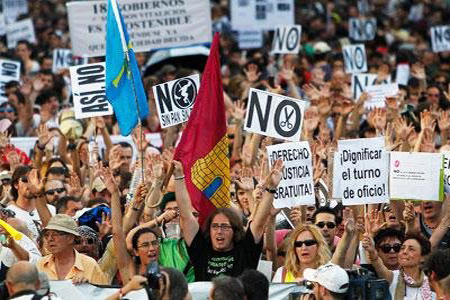by Ac. Krtashivananda
Unemployment in the eurozone hit 11.1% in May while the downturn in its manufacturing sector continued, according to official statistics.
A total of 17.56m people are now out of work marking the highest level since records began in 1995, according to EU statistics body Eurostat.
Meanwhile, the manufacturing Purchasing Managers’ Index (PMI), compiled by Markit, was stuck at 45.1 in June. Any reading below 50 indicates contraction.
The data compounds the gloomy outlook for the eurozone where companies have reduced or frozen spending levels – including labour costs – as fears over the impact of the ongoing debt crisis have reduced confidence in future growth.
Joblessness in the eurozone has risen for the past 14 months.
In Spain, which has the highest unemployment rate in the 17-bloc nation, one in four people is now out of work.
The downturn in employment is reflected in the eurozone’s manufacturing sector. The closely-watched manufacturing PMI’s unchanged reading of 45.1 in June means it remains at its lowest reading for three years.
The survey’s employment index fell to 46.7 in June, its lowest since January 2010, from 47.1 in the previous month, signalling accelerating job cuts.
“Companies are clearly preparing for worse to come, cutting back on both staff numbers and stocks of raw materials at the fastest rates for two-and-a-half years,” said Chris Williamson, chief economist at data provider Markit.
Whatever name you give to the EU financial support for Spain, one thing is clear. Spain alone was unable to go to the financial markets and raise the 100 billion Euros or so it needs to meet the capital requirements of its banking system for 2012/2013. The country’s leaders wanted one of the European funds (the EFSF perhaps) to inject the money directly into the banking system, but Europe’s leaders said no, it would need to be the Spanish sovereign that borrowed (via its bank reorganization fund FROB), and responsibility for repayment would lie with the Spanish state.
So, five years after one of the largest property bubbles in history burst, with an economy which has fallen by around 5% from its pre-crisis peak and is now expected to contract by around another 2% this year, while unemployment is hitting the 25% mark, Spain has finally had to accept that it cannot manage alone.
Whatever way you call the aid Spain is now receiving from Europe it is clear that this is the beginning and not the end of what is likely to be a long process, one which will now inexorably lead to either the creation of a United States of the Euro Area, or to failure and disintegration of the Euro. There will be no middle path, so the stakes are now very high for all involved.
Spain has to think seriouly about increasing purchasing power of the people and avoid imported goods to meet their daily neccessities moblising local resources. Emphasising on small scale industries instead of big capital industries should be the thrust. Eu must take initiative to meet the capital requirement. Otherwise Spain may switch over to local curreny remaining in Euro Zone.


